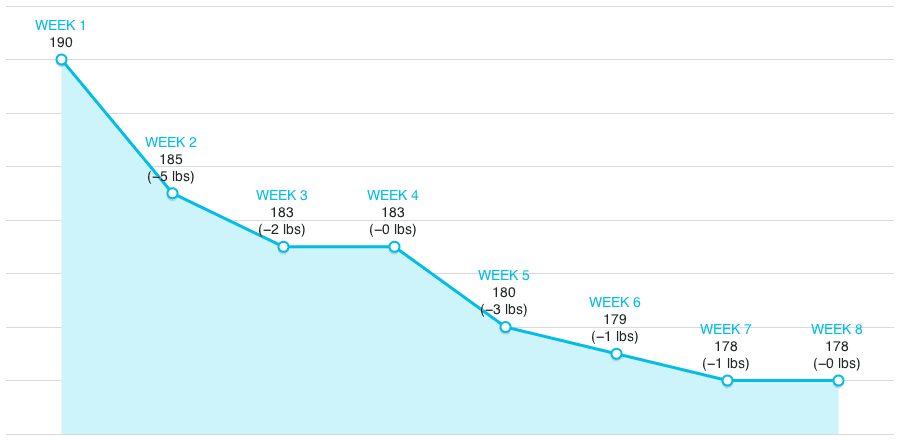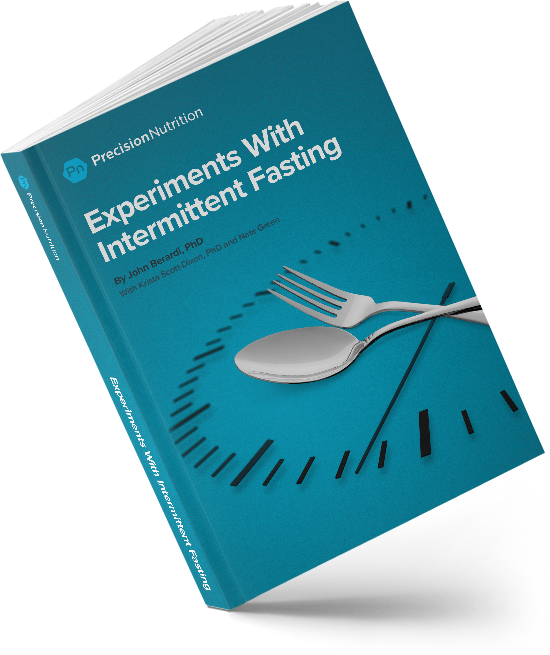Chapter 6
The Weekly Fast: My first intermittent fasting experiment
Fasting was new to me, so I chose to start simple. By intentionally biting off less than you can chew, you can achieve more than you thought possible.
I know it’s gratifying to think: “I’m gonna do my research, learn everything I can, adopt the perfect plan, and then I’ll crush this.” But that’s just your ego talking. And its eyes are much bigger than its stomach.
Under these conditions, people rarely ever crush it. Instead, here’s how it usually plays out:
- You waste a lot of time reading books and “researching” on the internet. You’re looking for the perfect program and after precious days, weeks, months of inaction, you finally find it. Hurray!
- You create a massive, all-encompassing, awe-inspiring action plan and begin to implement it. Out of the gate, you’re a total champ. You’re 100% disciplined and committed. Nothing can stand in your way. Cue the Rocky training montage.
- After a few weeks, maybe a month, you notice tension developing. At work, at home, in your relationships – something’s happening. You’re having trouble sticking to the program you created. You lower your head and tell yourself, “It’s just for a little longer.”
- By now, you’re either panicking or have succumbed to apathy. Your self-talk is on the decline. “I guess I’m not cut out for this. Maybe other people can do it, but they must not have a life. Me, I’ve got a job, a family, responsibilities. This is impossible.”
- You can’t figure out what’s going wrong. Eventually, something’s got to give. The quest ends prematurely. (Or, in some radical cases, it doesn’t end, and you end up jobless and homeless, living in an old VW bus in Santa Monica, California.)
The sad truth is that it never had to happen this way. If you had taken the smallest, simplest action step available to you – even if it wasn’t the “perfect” one – you could have built some positive momentum. You could have built this new change into your life.
As your capacity grew, you could have added new, equally simple action steps. You could have built things up, one upon the other, slowly, steadily, all the way to the achievement of your goal – a goal you can now sustain because you’ve grown yourself along with the change.
Trust me, I know all about this. Every year our coaching program gets 6,000 fresh new recruits, all of them thinking they’re going to come in and – yep – crush this. Yet only the ones who allow us to hold them back, to do change as it’s meant to be done – slowly and steadily – actually crush the program.
Experiment #1: The Weekly Fast
In the spirit of simplicity, I made my first fasting experiment as manageable as possible. I decided to fast one day per week, every Sunday.
Of course, I normally eat well – high protein and veggie intake, mixed nuts, fish oils, properly prepared legumes, a fairly low starch and sugar intake, and 2 litres of water per day. Plus I exercise 4-6 times per week. I decided to keep all that the same.
I just ate a little less food on my non-fast days (I dropped roughly 500 calories per day from normal intake), added an “eat whatever I want” day, and added a fast day.
Here’s what my schedule looked like:
| Day | Exercise | Nutrition |
|---|---|---|
| Monday | Upper body strength exercise – 45 minutes | Moderate calorie intake (2500 kcal) |
| Tuesday | Treadmill sprints – 10 minutes | Moderate calorie intake (2500 kcal) |
| Wednesday | Upper body circuit exercise – 30 minutes | Moderate calorie intake (2500 kcal) |
| Thursday | Treadmill sprints – 10 minutes | Moderate calorie intake (2500 kcal) |
| Friday | Lower body strength exercise – 45 minutes | Moderate calorie intake (2500 kcal) |
| Saturday | 100 push-ups before each meal | Eat whatever I want, stopping at 10 PM (5000 kcal) |
| Sunday | No exercise | Fast until Monday morning (0 kcal) |
How I trained during the Weekly Fast
Here’s what my workout program looked like:
Day 1 – Monday
Upper body strength: 45 minutes
(Upper body warm-up)
A1. Flat dumbbell bench press 5 sets × 3 repetitions
A2. Pull-ups 5 sets × 10 reps
B1. Bent-over rows 5 sets × 3 reps
B2. Low cable crossover 5 sets × 10 reps
C1. Explosive bench press 5 sets × 8-10 reps
C2. Explosive inverted rows 5 sets × 8-10 reps
Note: “A1” and “A2” mean that I alternated those sets. I did one set of A1, then one set of A2, then back to A1, for a total of 5 “rounds”. Same for B1/B2 and C1/C2.
Day 2 – Tuesday
Treadmill sprints – 10 minutes
Walk 2 minutes
Sprint 15 seconds at 9 mph and 12% incline
Rest 15 seconds
Repeat 10 times
Walk 2 minutes
Day 3 – Wednesday
Upper body circuit – 20 minutes
(Upper body warm-up)
A1. Close-grip push-ups x 20 reps
A2. Inverted rows x 20
A3. Flat DB press x 10
A4. Bent-over DB rows x 10
A5. Band crunches x 10
A6. Reverse hypers x 10
Go through exercises in order specified, with no rest in between exercises. Rest 1 minute after finishing A6. Repeat 5 times.
Day 4 – Thursday
Treadmill sprints – 10 minutes
Walk 2 minutes
Sprint 15 seconds at 9 mph and 12% incline
Rest 15 seconds
Repeat 10 times
Walk 2 minutes
Day 5 – Friday
Lower body strength – 45 minutes
(Lower body warm-up)
A1. Front squat 5 sets × 3 reps
A2. Swiss ball leg curls 5 sets × 10 reps
B1. Deadlifts 5 sets × 3 reps
B2. Dumbbell squats 5 sets × 10 reps
C1. Kettlebell swings 5 sets × 8-10 rep
C2. Speed deadlifts 5 × 8-10 reps
Note: you might be wondering about the Saturday push-ups. Nothing magical there. My chest is my weakest body part in terms of muscular development, which is why I added an extra 400-500 push-ups on one non-exercise day.
What I ate during the Weekly Fast
I didn’t follow a diet per se. I just followed these rules:
Monday through Friday
Meal frequency: Eat 4 meals per day, with about 4 hours between meals.
Meal content: Most meals should contain:
- 2 palms (8 oz) of lean protein
- 3 fists (3 cups) of veggies
- 1/2 handful (1/4 cup) of raw nuts
- 1/2 handful (1/4 cup) of legumes
- 500 mL (2 cups) of water
Supplements: Each day I took:
- 1 multi-vitamin
- 4000 IU vitamin D
- 15 mL (1 tbsp) fish oil
- 10 g BCAA capsules before workouts
Saturday
Eat whatever I want, with the following rules:
- break most of the rules above
- eat until satisfied, not until sick
- focus more on increasing carbohydrates instead of fats
- do 100 push-ups before each meal
- stop eating at 10 PM
Sunday
Fast from 10 PM on Saturday till Monday morning. Eat 3 “meals” on Sunday, with each meal being:
- 1 L (4 cups) water with 1 scoop greens drink
- 250 mL (1 cup) green tea
- 5 g BCAA capsules
Sample meals – Monday to Friday
Here are some sample Monday-to-Friday meals:
Sample 1
- 8 oz chicken thighs (marinated in olive oil and hot sauce)
- 3 cups of cole slaw, broccoli slaw, and carrot slaw salad
- 1/4 cup of lupini beans mixed in salad
- 2 tbsp raw mixed nuts in salad
- Salt, pepper, seasoning
- 2 tbsp white vinegar as dressing
- 2 tsp Udo’s oil as dressing
Sample 2
- 5 whole eggs
- 2 slices bacon
- 4 tbsp homemade pesto (with basil, spinach, raw cashews, olive oil)
- 1/4 cup of refried beans
- 1/2 red bell pepper
- 2 tsp fish oil
Sample 3
- 2 scoops unsweetened whey protein powder
- 1 cup unsweetened almond milk
- 1 scoop chocolate raspberry flavoured greens+ supplement
- 2 tsp fish oil
Sample 4
- 8 oz extra lean ground beef
- 2 cups of spinach, tomato, green pepper, and onion salad
- 1/4 cup of kidney beans mixed in salad
- 1/2 cup home-made guacamole in salad
- Salt, pepper, seasonings
- 2 tsp Udo’s oil as dressing
- Zone bar (chocolate mint flavour)
Sample 5
- 3 spicy turkey sausage links
- 2 cups of frozen vegetable medley
- 1 cup sauerkraut
- Salt, pepper, spices
- 2 tsp fish oil
Of course, during these 8 weeks, I used a lot of different meal combinations. But the central theme was to include about 8 oz of protein (2 palms worth), a ton of veggies, some nuts, some legumes, and some healthy oils. Once in a while I threw in a protein bar or protein shake, but these were the exception rather than the rule. When I ate out at restaurants, I made it as simple as possible: large portion of protein, lots of veggies, hold the starches, and include some oil and vinegar dressing. Easy, easy, easy.
Sample meals – “Eat what I want day”
On my “eat whatever I want” day, I did exactly that. Here are some examples from those days.
Sample 1
- 2 small chorizo soft tacos
- 2 small beef soft tacos
- 2 small fish soft tacos
- 2 small chicken soft tacos
- 1/4 cup guacamole
- 1 Corona beer
Sample 2
- 3 whole eggs
- 2 pieces bacon
- 1 green pepper
- 1/2 cup oatmeal with chocolate protein
- 2 tbsp peanut butter
- 2 tbsp chocolate chips
Sample 3
- 2 chicken breasts in a large salad
- 1/2 pint of Ben and Jerry’s ice cream
- 2 chocolate chip cookies
Sample 4
- 15 pieces of sushi
- 1 cup seaweed salad
- 1/2 cup green tea ice cream
Calorie intake
Generally, I ate about:
- 2500 calories on my moderate intake days
- 4000-6000 calories on Saturday
- 0 calories on Sunday
This made my daily average intake about 2500 calories for the entire week.
For obsessive-compulsive types
Obsessive-compulsive people: I could go on and on about why you shouldn’t focus all your attention on calorie counting and achieving the perfect calorie balance. But that’s another topic for another day.
Instead, I’ll simply say this: Although I did write down what I ate each day in a little notebook, I didn’t actually try to predict my exercise expenditure or balance it out with my energy intake using one of those online calorie counter thingies. In fact, I almost never do any of that anyway. (Nor, probably, should you. Ever.)
Instead, I followed the “fist” and “palm” rules: a cup of veggies is about the size of my fist; 4 oz of protein is a cut of meat, poultry, or fish about the size of my palm. These rules get me in the right calorie zone without the stress and inconvenience of weighing and measuring every meal. Close enough and hassle free.
I also listened to appetite and hunger cues, which is something every health- and fitness-conscious person should learn how to do.
2500 calories per day is the number I’d typically used to lose weight and body fat in the past, so it was a good point of comparison. If this plan was more effective than previous attempts, or easier, I’d know I was on to something.
Of course, you will need to use a different calorie estimate that reflects your own body size, metabolic rate, and activity levels. In other words, our fists and palms probably aren’t the same size. But I’m sure you already figured that out.
So what happened to me?
The Weekly Fast: The results
Weight loss
I lost 12 pounds of body weight during the first 8 weeks on this plan. I started at a weight of 190 pounds and ended up weighing 178 pounds.
Of course, this weight loss wasn’t linear. It looked more like this:

As you can see, there was some immediate weight loss, probably from the initial body water losses common with a lower carbohydrate diet. After that, I saw a steadier loss of 1-2 pounds per week.
Note that my weight – and anyone’s weight, for that matter – fluctuates throughout any given week. This is normal, and exaggerated further when cycling calories. After my high calorie days, my weight was up 1-2 pounds. After my fasting days, it was down 1-2 pounds. That’s why it’s important to only compare the results of your reference day weigh-in each week, even if you’re weighing yourself every day, like I did.
My reference day was Friday morning.
This was the furthest day from my last high calorie and fasting day, the day that my weight was most likely to be stable. Expect weight ups and downs. Don’t fret over them. If your energy intake is right, the weight gain is not body fat. It’s water weight. Just trust your reference day weight and if it’s progressively going down over time, all is well.
Body fat
According to my Intelimetrix body fat device, 60% of the losses (7.2 pounds) I experienced during the first 8 weeks were fat pounds. The rest (4.8 pounds) was “lean mass.” I wasn’t too worried about that. Lean mass is made up of all non-fat weight in the body, most of which is water. Because I was eating enough protein and my strength stayed stable during the phase, I expect that most of the lean mass I lost was actually water weight.
Mood and energy
In describing mood and energy, I think it’s important to separate general feelings of mood and energy vs specific feelings on the day of the fast. It’s also important to note that these feelings will change from week to week.
When I began this experiment, the first few fasting days were a challenge.
Early in the day, as hunger signals accumulated, I found myself constantly thinking about food. That’s when I learned it’s important to stay busy with different errands and tasks. If I was idle, my inner adolescent acted up: “Waahh, I’m hungry! This sucks!” When I kept busy, I thought much less about eating, and didn’t feel compelled to eat.
As the day progressed, my physical hunger actually diminished, although it came back in waves. However, I felt my energy progressively decrease, too; I didn’t want to move around much, so I didn’t. After about 4 PM on each fasting day, I just took it easy, spending time with my family around the house or in the yard. And definitely no workouts on the fasting days.
I did feel a little short-fused and moody during the first few fasting days. This is a normal consequence of the hormones released during fasting. It’s to be expected, although it was still frustrating for my family and I. I needed to be extra vigilant about keeping myself calm, taking deep breaths before responding to a challenging comment, and not overreacting to small things.
While I’m sure none of this sounds all that appealing, I think it’s important to note that none of these feelings were as bad as I expected they’d be. Rather than making me totally miserable, they just slightly annoyed me. As long as I kept busy and was mindful of my interactions with friends and family, things were okay.
Here’s another hopeful message: As you practice this type of fasting, it gets much, much easier. My first one-day fast was rough. With each subsequent one-day fast, it got better. By my 4th or 5th fast, I was barely uncomfortable at all. And by my 7th or 8th fast, I was having great days.
This leads nicely into a discussion of my general feelings of mood and energy. While my body weight and fat changes were on par with previous fat loss experiments, I noticed a big difference in how I felt on the days I wasn’t fasting.
During previous diets, within four weeks my energy would go down, my training would suffer, and a brain fog would set in, all of which would kill my memory and concentration. I often described this feeling as “the life being drained outta me.” It wasn’t a huge problem, but it was annoying. I couldn’t wait to “get back to normal.”
On the other hand, with this fasting plan, I didn’t really experience the same complaints. In fact, I never really felt like I was “dieting” – except for the one fasting day per week (see description above). Most of the time, I felt minimal brain fog, very few intense food cravings, and not much discomfort. With a family to care for and a company to run, this is very important to me.
I attribute some of these benefits to the high calorie days as well. On these days I got to eat all sorts of non-diet foods, within reason. And I got to eat till I was full, something you just don’t get to do very often when trying to lose weight.
There’s more to it than the psychological aspects, though. I’m fairly confident there are some small metabolic and hormonal advantages to having at least one higher-calorie day each week, especially when you’re eating at a deficit for the rest of the week, you incorporate a day of fasting, and you plan on eating this way for a while. They might not be obvious in the short run, but I think something is going on.
In addition, on the fasting days, I had lots of time for other things. I discovered how much time cooking, eating, and cleaning takes. Plus, after a solid day of fasting, I felt “cleaned out” and ready for another great week of fat loss. Again, I suspect there’s more to it than the psychological element – there may be some small metabolic and hormonal advantages to one extended fast per week. Nothing I could measure, though.
The Weekly Fast: Lessons learned
Now for the moment of truth: Was this plan more effective than conventional dieting approaches for fat loss? Here’s what I found:
- Fasting once a week as described above worked very well, but wasn’t measurably better than conventional dieting. Compared to previous fat loss experiments, I didn’t lose fat faster, preserve muscle mass better, or even end up with a healthier blood profile using this IF strategy.
- I did, however, enjoy it more. In terms of my mood, energy, and lifestyle, as well as in terms of compliance, I’d say this first experiment was a big success. I enjoyed the plan a lot more while still losing fat – and preserving lean mass – at an acceptable rate. All good things.
- I’d fast this way again. This is a definitely an eating style I’d use again in the future if I had to drop some body fat or refine my body composition. I may even use it just to remind myself what real physiological hunger feels like. It’s easy to forget over time.
- Weekly fasting suited my lifestyle quite well. Personally, as long as I mitigate the early “side effects” of full-day fasting, I can skip eating one day per week, compensating for the no calorie fasting day with a higher calorie “eat what I want” day, and lose fat, preserve lean mass, and not suffer most of the typical diet-related complaints. That’s a pretty cool revelation, and a fun experiment to try at home. Of course, your mileage may vary.
But what about skipping two days of eating? Now that’s another story.





